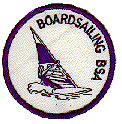SWIM TRUNKS EMBLEM
The Boardsailing, BSA Patch is NOT worn on the Uniform.
It is worn on the left side of the swim trunks.
Requirements
- Review the BSA guidelines for boardsailing and explain steps you have taken to follow each of the eleven guidelines found in Section V of Camp Program and Property Management, No. 20-920.
- Explain precautions to be taken for boardsailing on each of the following.
- Lakes
- Rivers
- Ocean or bay areas
- What is hypothermia? Describe to your counselor the symptoms of hypothermia. What special considerations in preventing hypothermia are necessary for boardsailing?
- Properly rig and prepare the sailboard you are using. Point out and explain the function of each of the following: uphaul, outhaul, downhaul, cleat, leach, tack, clew, foot, skeg, centerboard, wishbone boom, universal, luff, and center of effort. Explain how to steer the sailboard.
- Demonstrate your ability to uphaul the sail, find the neutral position to the wind (sail luffing), and control the board's position with foot movement.
- With supervision from your instructor, sail a course that involves beating, reaching, and running. Change tack by coming about.
Note to Counselors
Purpose
This award has been developed to introduce Scout-age children to basic boardsailing skills, equipment, and safety precautions; to encourage the development of skills that promote fitness and safe aquatic recreation; and to lay a skill and knowledge foundation for those who will later participate in more advanced and demanding activities on the water. Boardsailing BSA is well suited as a program feature for older Scouts at summer camp.
Counselors
Any person recognized and certified as an instructor by Windsurfer International or the United States Boardsailing Association may serve as a counselor for this award with the approval of the local council. A person trained and experienced in boardsailing skills and safety may serve as a counselor for this award in a Scout summer camp program under the direction and supervision of a currently certified Aquatics Instructor, BSA. All requirements must be completed as stated on this Boardsailing BSA application. The counselor should not omit, vary, or add requirements. The requirements should be taught and completed in the order in which they are presented on the application.
Recognition
Scouts completing the requirements will receive a swimsuit patch, No. 00249. A completed award application should be submitted to the local council by the counselor or unit leader.
Teaching Areas
Instruction must be conducted on a body of water meeting the criteria defined in the BSA guidelines for boardsailing. (See the "Aquatics" section of Camp Program and Property Management, No. 20-920.) A steady five- to seven-knot breeze is ideal for beginner practice. Initial water entry and practice should be on a gradual beach that meets Safe Swim Defense standards. The body of water should be free of other traffic, and be protected from shore and open water so that students are within fifty feet of assistance at all times during beginner instruction and practice.
References
A number of useful publications are available from equipment suppliers. The following are recommended:
- The Complete Guide to Windsurfing, by Jeremy Evans
- The Sailboard Book, by Jake Grubb
- Windsurfing, by Roger Jones
- Boardsailing Made Easy, by Chip Winans and Mimi Greenwood
Board Sailing Guidelines
(Found in Section V of Camp Program and Property Management, No. 90-920)
Whenever Scouts or Explorers participate in boardsailing activities, the following guidelines and practices should be followed:
- A responsible adult must supervise all board-sailing activities. The supervising adult must be experienced and qualified in water safety (BSA Lifeguard, Red Cross Advanced Lifesaving, or YMCA Senior Lifesaver) and must be an experienced board sailor or use assistants with such qualifications.
- Only persons who have successfully completed the official BSA swimmers test in the current year may participate in a board-sailing activity.
- All participants must present evidence of fitness assured by a complete health history from a physician, parent, or legal guardian. The adult supervisor should adjust all supervision, discipline, and protection to anticipate any potential risks associated with individual health conditions. In the event of any significant health condition, an examination by a physician should be required by the adult supervisor.
- All participants should receive instruction in boardsailing skills and safety from an experienced board sailor.
- All persons must wear an approved U.S. Coast Guard personal flotation device (type II or III recommended) at all times while participating in a board-sailing activity.
- No one sails alone; always have a buddy on the water (in a boat or on another board). Board sailors must stay within view and easy rescue range of lookout in an appropriately equipped rescue boat.
- No board-sailing at night, at dusk, or in rough water. Weather and water conditions must be known and understood in advance of any board-sailing activity, and weather forecasts should be studied. Exposure suits are recommended for cool water or cool weather.
- Avoid swimming areas, fishermen, and underwater diving activity. Use designated board-sailing beaches when available. Stay out of traffic or channels that have heavy traffic.
- All equipment should be safety checked and repaired as needed before each use.
- When in difficulty, a person should stay with the board and not attempt to swim ashore.
- All participants should know, understand, and follow the rules and procedures for safe board-sailing. The supervisor should encourage the individual exercise of good judgment and self-discipline, and assure that safety rules are fairly and constantly enforced.
(footnotes)
Source: Boy Scout Requirements 2019








